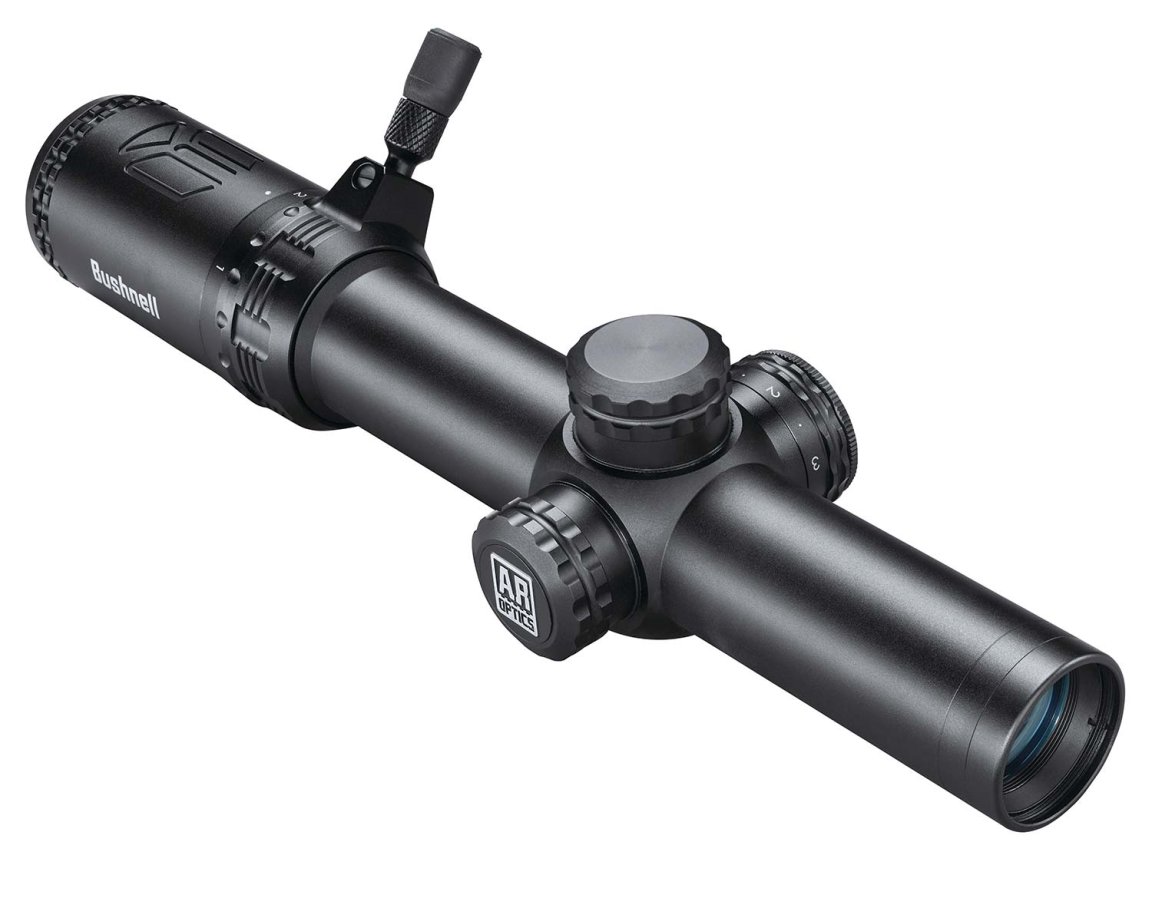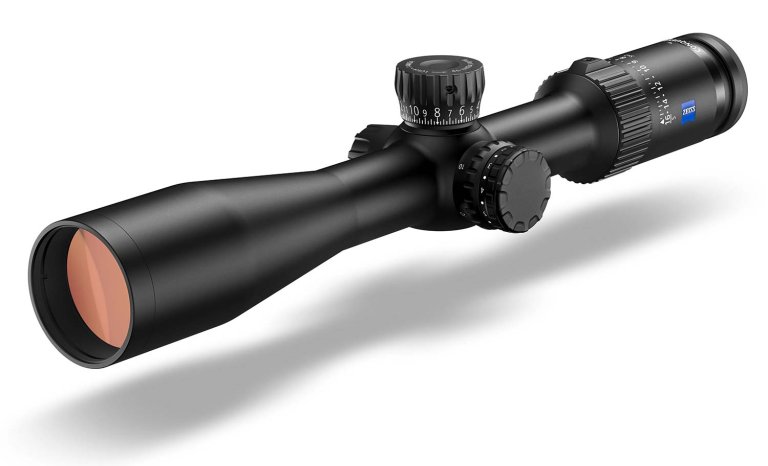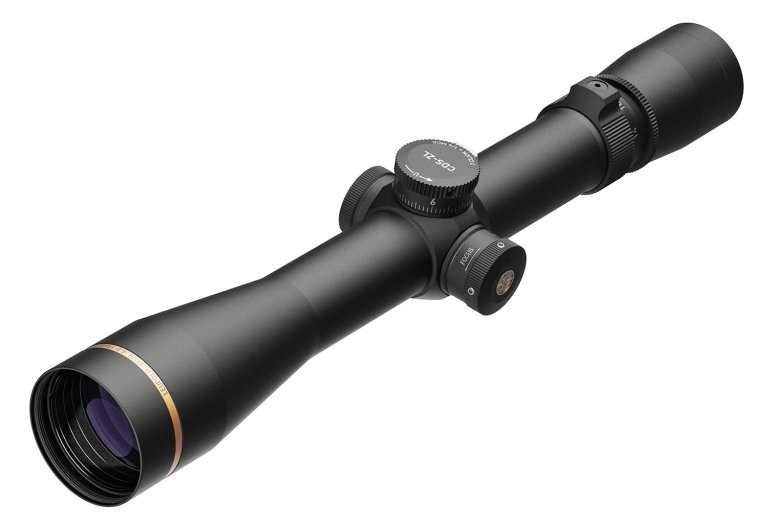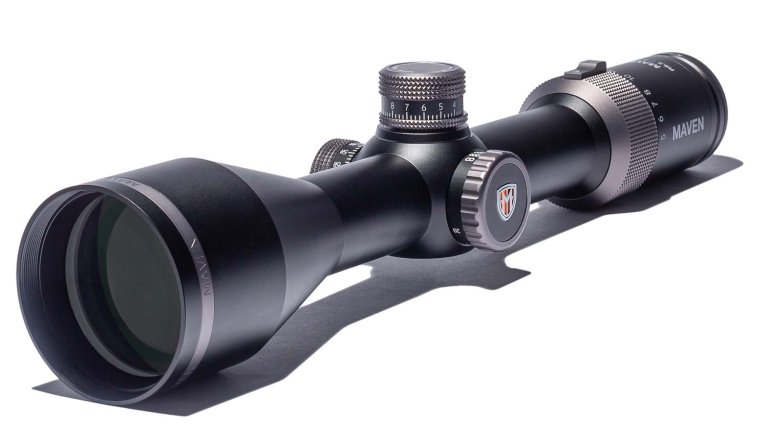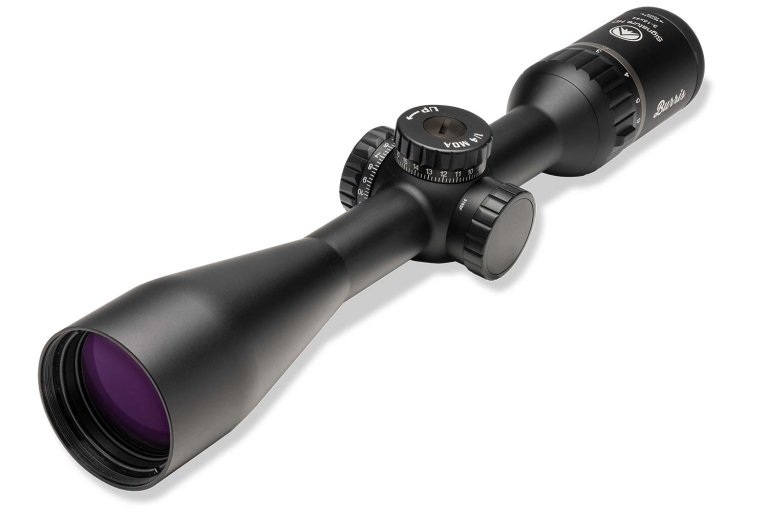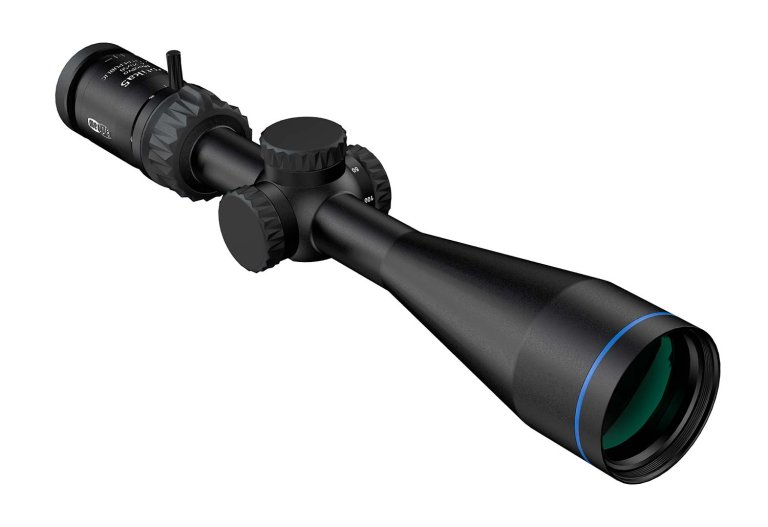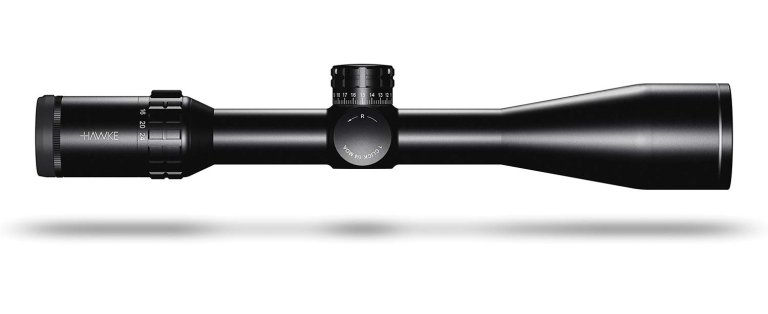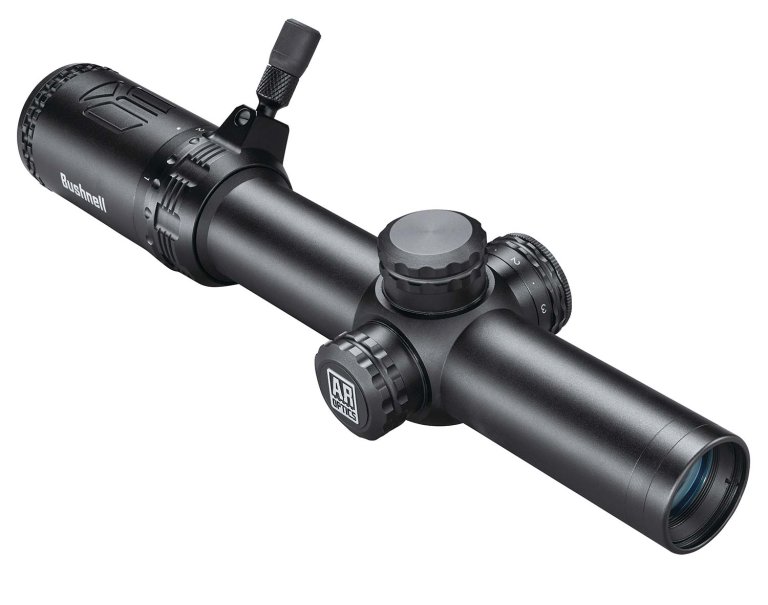We may earn revenue from the products available on this page and participate in affiliate programs. Learn More ›
The way it’s going, you’ll have a specialized scope for every rifle in your collection. Your 6.5 Creedmoor will need an optic with a reticle tuned to the trajectory of the 140-grain Federal Fusion it shoots so well. Your .300 Win. Mag. will require a first-plane precision scope in order to place bullets beyond 1,000 yards. And only a primitive shooter would shoot an AR chambered in .223 without a matching .223 riflescope.
Whatever happened to buying a scope that can fit a variety of rifles? Those versatile riflescopes are out there, and if our 2020 Optics Test is an indication, the category is healthier than ever.
Read our review of the best new riflescopes of 2021, here.
Because of the rise in specialization—it’s been compounded with the explosion in the number of purpose-built precision target scopes—for a couple years we have divided our riflescope evaluation into two separate categories. Those scopes intended for long-distance shooting are considered in our Precision Riflescope category. Everything else, especially those scopes that are designed for hunting but which have attributes like bullet-drop reticles or turrets designed for dialing, are grouped in what we call our Versatile Riflescope category.
This year, we tested 19 of these cross-over scopes (you’ll see only 17 write-ups here because we combined multiple configurations of the same model in a single review). They included four short-range scopes—from Athlon, Bushnell, and Konus, and newcomer Skinner Sights—that feature low magnification and configurations that can be used on everything from a personal-defense shotgun to an AR or even a slug shotgun or straight-wall cartridge rifle.
At the other end of the spectrum, our Versatile category included scopes with large objective lenses and high magnification that would be just as at home on an elk hunt as on the long-distance steel range. That wide variety of attributes makes head-to-head comparisons difficult, but by keeping in mind the organizing principle of the category—versatility—we made sense of this highly functional collection of scopes.
Before we dive into our evaluation, another observation: this is a class of relatively reasonably priced optics. Our Precision Scope category has a number of riflescopes that cost around $2,000. The average price of Versatile Riflescopes is $700. That’s still a lot of money, but smart shoppers can find a scope that fits a wide variety of rifles for well under $500.
For the rest of our Optics Test Reviews, click the links here:
- The 13 Best New Precision Riflescopes Put to the Test
- The 9 Best New Hunting Binoculars Put to the Test
- The 8 Best New Spotting Scopes Put to the Test
1. Editor’s Choice: Vortex Razor HD LHT 3-15×42

Our test team evaluates scopes on 10 attributes ranging from the utility of the reticle to the precision of the turrets and quality of the image, and awards a maximum of 10 points per consideration, for a total of 100 possible points. At the end of the evaluation process, we average those scores and calculate the winner. This year, we had 5 scopes that garnered between 77 and 81.5 points, and the winner—by half a point—is the excellent Razor HD LHT from Vortex.
Before I introduce the runners-up—from Zeiss, Meopta, Leupold, and Maven—let me gush about the Vortex. This might be the ultimate hunting scope, with an MOA-based hash reticle in the second focal plane that has excellent holdover and windage references. For those shooters who prefer to dial turrets to place bullets on distant targets, the exposed pull-to-turn elevation knob has excellent indexing and adequate positivity and features Vortex’s RevStop zero stop.
But this is a case where the complete package elevated the scope to the top finish. It weighs only 19 ounces, which makes the Razor HD LHT a good choice for a lightweight mountain rifle. It has a tasty push-button illumination system that makes it a good choice for low-light whitetail hunting. Its modest 42mm objective lens allows for low-profile mounting, and the ample dimensions of its 30mm tube give it the versatility to mount on a wide variety of rifles, including bolt guns with magnum actions.
We also felt that the price, a cool $1,000, is fair for all the utility the Vortex provides, especially considering the company’s excellent lifetime, fully transferrable warranty.
The scope isn’t without a few drawbacks. First, we’d like to see a revolution indicator on the elevation turret. Second, while the Razor earned a top score on our resolution range, we noted some surprisingly poorly coated internal lenses. And we’re not sure many hunters or shooters will need the whopping 32 MOA of holdover below the .35 MOA illuminated center dot.
But Vortex has addressed one potential shortcoming. I’m not a fan of exposed turrets on backcountry hunting rifles. It’s too easy for the knob to get knocked off zero as the rifle is pulled in and out of saddle scabbards or lashed to backpacks. But I took the Razor HD LHT on a horseback bear hunt in Idaho’s wilderness, and the exposed turret, which is firmly locked until pulled to turn, didn’t budge after days in scabbards and being subjected to the abuse of the mountain terrain.
If you’re looking for a scope that has some utility for a variety of target-shooting games but can handle just about any hunting challenge you throw at it, the Vortex Razor HD LHT is a wonderfully versatile choice.
2. Zeiss Conquest V4 6-24×50
While optics companies generally reserve the best expressions of their capabilities for their highest-priced flagship products, I’d argue that this precise, lovely, and extremely versatile riflescope should be considered Zeiss’s crowning achievement.
Let’s start with the excellent glass. The Conquest V4 provides a bright, sharp image right out to the edge, with no flaring or aberrations. The controls, from the side focus and 10-step illumination that lights a center-cross aiming point, are smooth and positive. The exposed turrets are tuned to ¼ MOA clicks and work marvelously with the hash MOA reticle (Zeiss calls it the ZBi #68) in the second focal plane that has 20 MOA of elevation (with hashes every MOA and numbered references every 2 MOA) and a total of 20 MOA of windage holds. If you’d rather dial a shooting solution, the elevation turret has 80 MOA and nearly three revolutions of travel, and a capable zero stop. The pull-to-turn windage dial features Zeiss’s innovate External Locking Windage Turret (ELWT), basically a zero stop for repeatable hold-off adjustments.
Aesthetically, this is the best-looking scope in the field, with elegant proportions framing its lustrous 30mm tube. Functionally, the only demerits we gave the Conquest are minor, and largely because our test model was a pre-production prototype (Zeiss, like most manufacturers, is experiencing supply-chain problems due to COVID-19). The 10th step in the illumination intensity didn’t work, and the etched chromium reticle threw some refracted light at highest illumination settings. Some testers questioned the need for the windage-turret limiter. With such a tight race for the top spot, those little dings cost the Zeiss important points.
We also tested a 4-16×44 version of the V4 that features the ZBi reticle, ELWT, and all the lovely design of the 50mm. This 44mm scope (it retails for $1,149) actually notched higher image quality and durability scores than its big brother.
The 50mm Conquest V4 scored just a half point below Vortex’s excellent Razor HD LHT for top honors in our Versatile Riflescope category. Because of its do-everything capabilities, your rifles will fight among themselves to have the Conquest atop them.
3. Meopta Optika6 2.5-15×44
With its Optika6, Meopta has a big-game scope that can handle the rigors of the backcountry, plus almost any light condition or shooting game, thanks to an innovative reticle that shines bright red in sunlight and glows green in low-light conditions. The proprietary coating that enables this magic trick—performed without batteries—is called “dichroic,” and the Meopta’s second-plane MOA reticle has a .8 MOA dichroic center dot and bold German 4 duplex stadia that are also treated dichroically. That makes for fast target acquisition at lower powers.
At higher powers, the BDC hashes (which are standard chromium and not dichroic) come into play, and provide holdover references out to 600 yards. The Optika6 has 70 MOA of total internal adjustment delivered by re-zeroable turrets with ¼ MOA clicks.
The Optika6 is the 30mm, 6-times magnification brother to last year’s 1-inch Optika5. Both feature excellent glass (the Optika6 posted one of the top resolution scores of this year’s field) and satisfying eye relief and field of view. Controls are smooth and positive without being mushy or slick, but most testers noted that they also seem oversized. Because the turret caps, parallax focus wheel, and power-changing dial are all covered with an aggressively textured rubber substance, one tester said the Meopta looks like it belongs at a tractor pull. That look is confirmed with the addition of a superfluous multi-position throw lever on the power ring.
But the scope’s operation is more refined than its rugged appearance. High-contrast indexing on the power ring and turrets make in-field adjustments quick and positive. Lenses are nicely coated, and the smallish objective lens—appointed with a handsome blue ring—allows low-profile mounting.
The Optika6 posted one of the highest versatility scores in our test, thanks largely to the highly functional dichroic reticle coating. We expect to see this technology show up in other Meopta product lines, and even other optics brands, in the coming years.
4. Leupold VX-3i CDS-ZL 4.5-14×40
In previous years, we’ve held firm to our insistence that brands could submit only one product per category. But we allowed some exceptions this year, since our online format allows for more submissions and longer running room for each review. That’s why you see a pair of Athlon, Konus, and Leupold scopes in the same Versatile scope category, unthinkable in the past.
In the case of the Konus and Athlon brands, the scopes represent entirely different configurations and purposes. In Leupold’s case, we allowed two configurations of the venerable VX-3 line, but they’re similar enough that we’re going to talk about both in the same extended review, just as we did with the Zeiss review above.
You’ve seen this scope in the past; in fact, Leupold introduced the VX-3 back in 1974, and it’s become a darling of hunters everywhere for its durable build, bright optics, and precise controls. What’s new is the availability of Leupold’s custom turret—tuned to the trajectory of your specific bullet, muzzle velocity, and ballistic coefficient—plus the push-button locking mechanism that prevents the exposed elevation turret from turning. That’s the ZL in the VX-3i’s name.
We tested the 30mm VX-3i (the “i” stands for “improved,” and not “illuminated” as many might assume), in 4.5-14×40 configuration. We also tested a 1-inch version of the VX-3i, in the 3.5-10×40 configuration (retail: $499). The main differences, besides turret diameter, is that the 1-inch scope contains a non-illuminated duplex reticle, but does not have side focus. The 30mm version contains a non-illuminated duplex Wind-Plex reticle with 1-MOA wind holds, extending 10 MOA on either side of the center aiming point. The 30mm version also has a very precise parallax focus knob.
Put plainly, these little scopes knocked our socks off. First, the 30mm Leupold won our low-light test, beating a handful of scopes with light-sucking 50mm objective lenses, on the strength of its Twilight Max coatings and excellent glass. Both scopes turned in excellent resolution scores, further evidence of very good glass and premium coatings. And we loved the extensive mounting dimensions in both versions.
But what really charmed us was the simplicity of the Leupold scopes. They don’t have complicated reticles or overbuilt turrets. But the addition of the Custom Dial System (ours were tuned to Hornady’s 143-grain ELD-X in 6.3 Creedmoor) gives these scopes a precision boost. We managed 1-shot hits from 100 to 600 yards, the limit of the single turret revolution.
That dial-and-shoot utility, plus the extremely light weight and trim profile of the VX-3i, make these excellent choices for backcountry rifles. The 30mm VX-3i weighs just 13 ounces, but has a prodigious 64 MOA of internal turret adjustment.
The list of shortcomings is, well, short. Our custom turret dials slipped after periods of hard use, and we’d like to see some holdover references (like those in Leupold’s excellent B&C BDC reticle) so users can choose between holding and dialing for distant shots.
Those quibbles seem pretty petty, considering all the hard-wearing versatility that these simple and lovely scopes offer a range of hunters shooting a wide swath of rifles.
5. Maven RS.3 5-30×50
This stout billyclub of a scope made us scratch our heads. With its first-plane reticle, exposed turrets, and a whopper magnification range, it would compete well in our Precision Riflescope category. On the other hand, the reticle doesn’t have anywhere near the number or finely rendered references that most precision scopes feature. And with some excellent holdover references on the BDC reticle, it seemed configured for a number of hunting pursuits.
So, we entered the 30mm RS.3 in our Versatile Riflescope category, where it finished in the top 5 out of 19 entries. That should tell you plenty about its attributes, which include excellent glass (it was runner-up in our low-light test and finished near the top of resolution scoring) and precise controls.
Let’s talk about that reticle, which Maven calls the SHR-W. It features 20 MOA of holdover and 10 MOA of windage holds on either side of the non-illuminated center-dot aiming point. Testers loved the hold-over utility of this reticle, but noted that it’s hard to see at magnifications under about 8X. And over 22X, the first-plane reticle gets so large that it obscures small targets.
We had similar pro/con perspectives on the turrets. The extremely positive ¼ MOA turrets are sharp and feature a whopping five revolutions of travel, but for a hunting scope, we’d like to see either locking or covered turrets. The elevation dial has a curious but effective external zero stop. Loosen the threaded collet, zero the turret, then screw the collet to the zero point and tighten it down. Theoretically, you can now turn your turret back to that starting point, but we noticed that if you really reef the turret, you can turn the dial below its established zero. It takes some doing, but eventually we got the two rotations—that of the collet and that of the turret—to work together. Still, there are better ways to zero-stop a turret.
On the pro side, we love the pewter-on-black styling of this scope. The optics are first rate. And, it’s important to note that the RS.3 has a variety of reticle options, including MOA and milliradian versions with more precision-shooting configurations. Those options elevate this from simply a hunting scope into one that has some pretty good precision-shooting capabilities. That, more than any other attribute, is the very essence of a versatile riflescope.
6. Great Buy: Burris Signature HD 3-15×44
Before you dismiss this as just another hunting scope, take a closer look at the E3 MOA reticle. It’s a bullet-drop reticle in the second plane, like many of its peers, but I’d call it a mini Christmas tree because of its smart windage holds and its fast and simple holdover references out to 400 yards for standard calibers and 500 yards for magnums. At lower magnifications, from 3X to about 5X, the reticle is fast, especially with the center-cross illumination lit up. But at middle and high magnifications, the references are smart and useful without cluttering up the image.
We strap all our riflescopes to precision .22 bolt guns to test reticle range and subtensions. With a 100-yard zero, we could place first-shot hits with the Burris out to 180, 250, and 310 yards, using a combination of holdover references and dialing the very positive pull-to-turn exposed turrets.
The Signature has 80 MOA of total internal adjustment, right in line with what you’d expect from a scope of this class, but it delivers that range in a 1-inch tube, rather than the standard 30mm tube. The 44mm objective lens allows for low-profile mounting, and the ample dimensions on the tube make the Signature HD work with a wide variety of action lengths and mounting systems, adding to its versatility score.
If we have quibbles, it’s with the noticeable distortion at the edge of the image and with the slight imperfection of the etched reticle—it picks up jags of refracted light when illuminated. Some testers also thought that the Burris’s proportions were a bit off. The Signature HD is built on a tube as thin as a wasp’s thorax, but the thrusting ¼ MOA turrets and dual parallax/illumination module are a bit proud. But considering the overall package, this is a great expression of a versatile riflescope, and at only $500, a helluva bargain.
The Burris Signature HD won earned the top Price/Value score in our Versatile Riflescope category, and wins our Great Buy award. We couldn’t be happier for a bright, tight, and extremely capable riflescope.
7. Primary Arms GLx 4-16×50
We struggled a bit to determine whether this scope, a freshman effort from a brand that’s better known as distributor of tactical guns and accessories, fit into the Versatile or Precision riflescope categories. Attributes that make it an adequate precision scope include first-plane MIL-dot reticle, oversized exposed turrets with push-button locks, and 10-step illumination that lights up the entire center stadia of the reticle.
But testers reckoned that the reticle, while useful, doesn’t have enough references to use at far-distant targets on a precision-rifle course. And while the 4-times magnification is adequate for most shooting uses, it doesn’t have the 25X to 30X that many precision shooters require to really pick out targets well beyond 1,000 yards.
Still, all those attributes make it a very useful versatile scope, with plenty of competence for hunting and for most target games. The reticle is clean and useful, though we’d like to see more hold references below the horizontal crosshair. With 25 MILs of internal adjustment, you can dial all day to targets that holdover doesn’t reach. About those turrets. They are the size of tea saucers (actually 1.5 inches) with enough gripping surface and knurling to turn with heavy gloves. The push-button locking system on both the elevation and windage turrets is smart and useful, to keep the oversized dials from being inadvertently knocked off zero. Testers felt that the turret clicks should have a bit more positivity, considering all the tactical attributes of the scope.
The GLx performed very well in our low-light test, finishing in third place, and turned in a good resolution score. We felt the price was fair for all the utility this scope delivers, and we’re eager to see future generations from this brand that clearly understands the requirements of a wide variety of shooters.
8. Bushnell Prime 3-12×40

This scope personifies the very definition of a versatile optic. It’s actually 7 scopes in one, thanks to its ingenious swap-a-turret build that enables users to riff from .22 rimfire to muzzleloader to straight-wall cartridge back to .17 rimfire, just by trading out elevation turrets.
Bushnell is on to an important trend. If you consider a duplex reticle the standard of conventional aiming points, then how that aiming point is moved inside the scope can vary depending on turret, and Bushnell has a turret for just about any shooting platform. Switching turrets is as simple as unscrewing a locking disk on the top of the elevation dial, removing the turret, slipping the next one over the brass gears, and then tightening the locking disk.
The Prime ships with a generic ¼ MOA turret, another tuned to the trajectory of the .17 HMR, one tuned to .22 Long Rifle ballistics, and another tuned to the 450 Bushmaster. The remaining three turrets are all based on variations of slow-moving projectiles. There’s a turret tuned to a 12 gauge slug but it also matches the trajectory of a 350-grain muzzleloader projectile, and another that matches 300-grain bullet dynamics when pushed by three blackpowder pellets. The final turret is tuned to 20 gauge slugs or a 300-grain muzzleloader bullet pushed by two blackpowder pellets.
Whew, that’s a lot of variation, and given all the utility available for $229, it’s a raging bargain, especially for a beginning plinker or someone who wants to swap the same scope between a number of platforms.
There are a few shortcomings with the Prime, though. The image shows significant edge distortion and a type of optical aberration that’s known as pincushioning, or a perceived swelling at the center of the image. The Bushnell scored near the bottom in our low-light testing. We also struggled a bit with the turret operation. It’s hard to tighten the locking disk without moving the turret, and the disk comes loose easily.
Still, if you’re looking for a do-everything riflescope that can migrate from a rimfire to a shotgun to a muzzleoader to a straight-wall cartridge rifle, this is a pitch-perfect product.
9. Meopta Optika5 4-20×50
We’ve already riffed on all the prodigious attributes of Meopta’s Optika6 scope, the 30mm version with dichroic reticle. Normally, we wouldn’t consider a second model from the same company in the same category, but because the 1-inch Optika5 was introduced in the same year, we’re including it here.
We’re also including it because it has significant differences from the Optika6. For starters, the Optika5 has a 5-times magnification range (compared to the 6-times range of the Optika6 line), and our Optika5 has a big 50mm objective lens, which allowed it to score in the top third of our low-light rankings. Its excellent glass also helped it to a top resolution score.
Like the Optika6, the 5 has oversized controls that are heavily textured to assist operation, even with gloved (or even mittened) hands. Testers thought the “tire-tread” texturing was a bit much, but they do make both coarse and fine adjustments a cinch. Another similarity, capped turrets with ¼ MOA clicks and a power-assist throw lever on the oversized magnification dial.
Unlike the Optika6, this scope features a center-dot illumination with six intensity steps, and it has a second-plane BDC reticle with holds out to 500 yards (600 yards with a magnum caliber zeroed at 200 yards), plus simple windage marks for a 10mph 90-degree wind. The reticle is serviceable, but it’s also pretty small and crowded, which complicates longer-distance precision work. Testers felt the BDC reticle references could be larger and more extensive.
But for a hunting rig, there’s a lot of simple utility here. We felt the price, the image, and the overall operation fell into the satisfying middle of the crowded field of versatile optics.
10. Hawke Frontier 30 4-24×50
An extremely versatile 30mm scope with wonderful mounting dimensions and a light-hungry 50mm objective lens, this interesting optic does a number of things pretty well, though it lacks some key features to elevate its precision.
Take the second-plane hash-style reticle with an illuminated center dot powered by six intensity levels. Hawke calls this the “LR Dot,” (the Frontier 30 line also has a MIL-dot reticle option) and it’s configured to be used for fast shooting at lower magnifications—think driven boars in Hawke’s native Europe. The reticle has references on the vertical stadia that can be used for bullet-drop holds out to 600 yards for standard big-game calibers. There are no windage marks. Testers liked the ability to dial the turrets to distant aiming points, but were frustrated with the imprecise holdover features.
The reticle is adjusted by exposed pull-to-turn turrets that have nicely positive ¼ MOA clicks and a satisfying 75 MOA of total internal adjustment and solid zero stops. The image quality was good, and testers liked the Frontier 30′s extensive field of view and ample eye relief. The test team also liked the lines of the big scope, which we expected to weigh more than its 23 ounces. In all, it fits the definition of a versatile scope but could use a few more reticle references for precision shooting work.
11. GPO Passion 5xi 3.5-18×56

The only 56mm scope in our Versatile Riflescope category, the Passion is a light-hungry beast, finishing as runner-up in our low-light test. The configuration is suited to twilight hunting, whether in a classic German “Hochsitz,” or high-seat hunting situation or posting up over a distant meadow for elk or Coues deer. The very precise and infinitely adjustable center-dot illumination adds to the GPO’s low-light chops.
The second-plane hash reticle (GPO calls it a MIL-dot) features regularly spaced windage and elevation references on the main stadia. That reticle layout tends to support dialing for distance and holding for wind, but the GPO’s capped turrets are mushier and less precise than “on-the-knobs” shooters will want. Still, there’s a ton of adjustment in the 30mm tube; we got four full revolutions of travel on the elevation turret, which like the windage knob, is re-zeroable with the right tool.
We loved the ample mounting dimensions and the open center crosshair that doesn’t obscure distant targets. We also liked the smooth precision of both the side focus and power-changing dial, and the included flip-up lens caps are first-rate. But the image was a bit disappointing, especially given that whopper objective lens, and testers felt that the price of the Passion 5xi was a bit out of line with its performance.
12. Bushnell AR 1-8×24
The name should give you some idea of the suggested audience for this extremely competent low-magnification optic built on a stout 30mm tube. But don’t think that its utility is limited to AR-15 platforms. The illuminated BTR-1 reticle in the second focal plane would make an excellent scope for a turkey shotgun, or for a flat-shooting muzzleloader, or atop a straight-wall cartridge rifle.
Testers loved the extremely fast target acquisition of the Bushnell AR at low powers, from 1X to about 3X, and decent precision references at magnifications from 5 to 8X. The 6-step illumination intensity—with intermittent shut-off between steps—is bright and positive without being distracting. The fold-down throw lever on the magnification dial is fast and handy. And, given the price, we thought the optics were pretty good.
There are some strange aspects to this platform, though. For starters, the turret adjustments are measured in mils (.1 mils per click) but the BDC reticle is best thought of as a MOA-based system. Second, we’d recommend few more illumination intensities. But overall, this is a well-made, mechanically tight optic with tons of utility, whether you mount it on an AR or on some other short-range platform.
13. Athlon Argos BTR Gen2 1-8×24
This is a solid choice for a shooter looking for a scope to mount on an AR-15. That’s clearly the intended market for this very adequate low-magnification optic that has a dot-and-circle illuminated MOA reticle in the second plane tuned to the drop of .223/5.56 all the way out to 600 yards. We liked the re-zeroable capped turrets with ½ MOA clicks and 100 MOA of total turret adjustment in the 30mm tube.
But the charms of this scope ended with that basic utility. We wanted to see intermittent stops between each of the 11 illumination settings, and we noticed significant peripheral distortion at almost all magnifications, but especially at powers below 3.5X. And the turrets’ clicks are muffled and indistinct.
That noted, the bullet-drop references are bang-on for a 55-grain .223 load, but you should also consider the Athlon as a very good choice for a .350 Legend or .450 Bushmaster, or any of the straight-wall cartridges now in fashion, or on a slug or turkey shotgun. Hell, I’d put this scope on a muzzleloader.
Categories where the Argos BTR Gen2 shined were versatility, reticle configuration, and price/value, though we also noted that other low-magnification scopes delivered nearly as much utility for the same, or lower, price.
14. Riton X5 Primal 3-18×44
There is a ton to like about this nicely appointed hunting scope from Riton. It has a very useful second-plane hash-style reticle with MOA-based references. Its ¼ MOA capped and re-zeroable turrets are positive and crisp. And the throw lever on the power-changing dial is useful for aggressive magnification adjustments in the field. Other plusses: a prodigious 95 MOA of total internal adjustment inside the 30mm tube, ample mounting dimensions, and the non-illuminated “PHR” reticle has just enough references for holdover and holdoff without getting too busy. With 30 MOA of holdover and 20 MOA of wind holds on either side of the center aiming point, there’s a lot you can do with this very smart reticle.
All those attributes earned the X5 Primal good mechanics, durability, and aiming-system scores. However, the image delivered by the scope was disappointing, especially consider its other talents. The Riton scored near the bottom of our low-light testing, and its optical resolution score was also surprisingly low. We noticed significant pincushion effect at lower magnification and both glaring and peripheral distortion were reported by all testers.
Our conclusion: once Riton invests in better glass for this class of scope, it will have a real winner on its hand. As it is, if you can overlook some squint-causing optics, you will love the positivity and utility of its excellent aiming system.
15. Skinner SKO-1624 1-6×24

While this is the first optics submission from Skinner Sights, it’s by no means the company’s first attempt at making you a better and more capable rifle shooter. Montana-based Skinner is known for its series of conventional sights—peep, express, and ladder-style sights—for vintage rifles. Given that background, this first magnified optic fits right in to Skinner’s niche. It’s a low-magnification scope that has tons of utility for everything from a dangerous-game rifle to a shotgun or personal-defense AR to a straight-wall cartridge lever gun. Skinner’s owner, Andy Larsson, has even made 500-yard shots with the scope atop a .308 Henry Long Ranger.
The 1624 (so named for its 1-6-power magnification range and 24mm objective lens) features a second-plane, center-dot illuminated German 4 reticle with four bullet drop references built on a 30mm tube. The capped and re-zeroable turrets have ½ MOA clicks and the illumination module features six intensity steps.
The holdover hashes are tuned for holds out to 600 yards with a 200-yard zero for standard 5.56/.308 calibers, or out to 500 yards with a 100-yard zero. The reticle is very fast, and while the hashes don’t obscure much of the target, we wish they were a little larger and more pronounced and featured some sort of wind references. Optically, the glass is decent but not premium.
But overall, this compact scope fits our definition of an extremely versatile optic, one that would be right at home on a wide variety of firearms. Testers also felt like the Skinner scope is priced right for the amount of utility it delivers.
16. Konus Event 1-10×24

The zoom range, or the multiplier effect of magnification, has been one of the factors that has measured the arms race of sports optics over the last few years. The 3-times zoom range (think 3-9X) was a standard for years, replaced by the 4-times (4-16X), and then the 5- and 6-times zoom range (the 1-6X or 3-18X). Now, it’s not unusual to see a 10-times zoom range, which is what Konus has delivered in its 1-10×24 Event short-range riflescope.
The prodigious magnification range is the most remarkable thing about this otherwise pedestrian scope, built on a 30mm tube. The second-plane dot/circle aiming point has both blue and red illumination and re-zeroable pull-to-turn turrets with ½ MOA click values. Testers noted a disagreement between those ½ MOA indexes on the turret cap and the ¼ MOA indexing on the turret itself.
The Event’s accessories add a bit of flavor to this scope. We liked the removeable zoom lever, and the flip-up lens covers are a nice add. But there’s a reason you don’t need 10-times magnification for a scope with a single aiming point. While the reticle is great for fast target acquisition at lower magnifications, it doesn’t have any references for precision work at higher powers. And, given the lack of versatility in the Konus, testers felt buyers could do better with lower-priced low-mag options from other brands.
17. Konus Empire 3-18×50

Konus has submitted some underwhelming scopes in the past, but this 6-times magnification, full-size scope built on a 30mm tube isn’t one of them. Sure, there are some head-scratching attributes here (the vivid blue reticle illumination) and some disappointments (the eye-watering image). But those are cancelled out by some fine touches, including an anti-cant bubble in the bottom of the image and a second-plane BDC reticle that has holdover references out to 600 yards.
We were also surprised at the Empire’s better-than-expected low-light performance. The magnification range is about right for a scope of this type, and we liked the whopping eight revolutions of elevation turret adjustment.
So far, so good. But the exposed pull-to-turn turrets with ¼ MOA click values are imprecise, and all the turning surfaces could use more positive texturing. And about that image… we noted significant peripheral distortion and glaring, and inside the optic we noted globs of grease, evidence of sloppy construction.
We also felt that the price was a bit high, considering all the scopes on the market with better optics and aiming systems with just as much, or even more, precision than the Konus.
